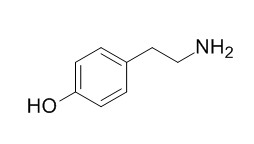Tyramine
Tyramine is a major mutagen precursor in soy sauce, being convertible to a mutagen by nitrite; it is the biological precursor of octopamine, both compounds are independent neurotransmitters, acting through various G-protein coupled receptors, they are antagonistic modulators of behavior and metabolism.
Inquire / Order:
manager@chemfaces.com
Technical Inquiries:
service@chemfaces.com
Tel:
+86-27-84237783
Fax:
+86-27-84254680
Address:
1 Building, No. 83, CheCheng Rd., Wuhan Economic and Technological Development Zone, Wuhan, Hubei 430056, PRC
Providing storage is as stated on the product vial and the vial is kept tightly sealed, the product can be stored for up to
24 months(2-8C).
Wherever possible, you should prepare and use solutions on the same day. However, if you need to make up stock solutions in advance, we recommend that you store the solution as aliquots in tightly sealed vials at -20C. Generally, these will be useable for up to two weeks. Before use, and prior to opening the vial we recommend that you allow your product to equilibrate to room temperature for at least 1 hour.
Need more advice on solubility, usage and handling? Please email to: service@chemfaces.com
The packaging of the product may have turned upside down during transportation, resulting in the natural compounds adhering to the neck or cap of the vial. take the vial out of its packaging and gently shake to let the compounds fall to the bottom of the vial. for liquid products, centrifuge at 200-500 RPM to gather the liquid at the bottom of the vial. try to avoid loss or contamination during handling.
Nutrients.2024, 16(19):3266.
J Colloid Interface Sci.2024, 662:760-773.
Front Pharmacol.2020, 11:566490.
J.Pharm. & Biome. Anal.2023, 2: 100018.
BMC Complement Med Ther. 2020, 20(1):94.
Korean J Dent Mater.2018, 45(2):139-146
J Sci Food Agric.2024, 104(7):4425-4437.
Br J Pharmacol.2024, 181(24):5009-5027.
Srinakharinwirot University2023, 2669.
Process Biochemistry2019, 87:213-220
Related and Featured Products
Neuron, 2005 ,46 (2) :247-60.
Tyramine Functions independently of octopamine in the Caenorhabditis elegans nervous system.[Reference:
WebLink]
Octopamine biosynthesis requires tyrosine decarboxylase to convert tyrosine into Tyramine and Tyramine beta-hydroxylase to convert Tyramine into octopamine.
METHODS AND RESULTS:
We identified and characterized a Caenorhabditis elegans tyrosine decarboxylase gene, tdc-1, and a Tyramine beta-hydroxylase gene, tbh-1. The TBH-1 protein is expressed in a subset of TDC-1-expressing cells, indicating that C. elegans has Tyraminergic cells that are distinct from its octopaminergic cells. tdc-1 mutants have behavioral defects not shared by tbh-1 mutants. We show that Tyramine plays a specific role in the inhibition of egg laying, the modulation of reversal behavior, and the suppression of head oscillations in response to anterior touch. We propose a model for the neural circuit that coordinates locomotion and head oscillations in response to anterior touch.
CONCLUSIONS:
Our findings establish Tyramine as a neurotransmitter in C. elegans, and we suggest that Tyramine is a genuine neurotransmitter in other invertebrates and possibly in vertebrates as well.
Arch Insect Biochem Physiol. 2003 Sep;54(1):1-13.
Tyramine and octopamine: antagonistic modulators of behavior and metabolism.[Pubmed:
12942511 ]
The phenolamines Tyramine and octopamine are decarboxylation products of the amino acid tyrosine.
METHODS AND RESULTS:
Although Tyramine is the biological precursor of octopamine, both compounds are independent neurotransmitters, acting through various G-protein coupled receptors. Especially, octopamine modulates a plethora of behaviors, peripheral and sense organs. Both compounds are believed to be homologues of their vertebrate counterparts adrenaline and noradrenaline. They modulate behaviors and organs in a coordinated way, which allows the insects to respond to external stimuli with a fine tuned adequate response.
CONCLUSIONS:
As these two phenolamines are the only biogenic amines whose physiological significance is restricted to invertebrates, the attention of pharmacologists was focused on the corresponding receptors, which are still believed to represent promising targets for new insecticides. Recent progress made on all levels of octopamine/Tyramine research enabled us to better understand the molecular events underlying the control of complex behaviors.
Gan. 1984 Jan;75(1):1-3.
Tyramine is a major mutagen precursor in soy sauce, being convertible to a mutagen by nitrite.[Pubmed:
6373470]
Tyramine was identified as a new mutagen precursor in Japanese soy sauce, becoming mutagenic after treatment with nitrite under acidic conditions. The mutagenic compound was identified as 4-(2-aminoethyl)-6-diazo-2,4- cyclohexadienone , and its specific mutagenic activity was 112 revertants/micrograms towards Salmonella typhimurium TA100 without S9 mix.



